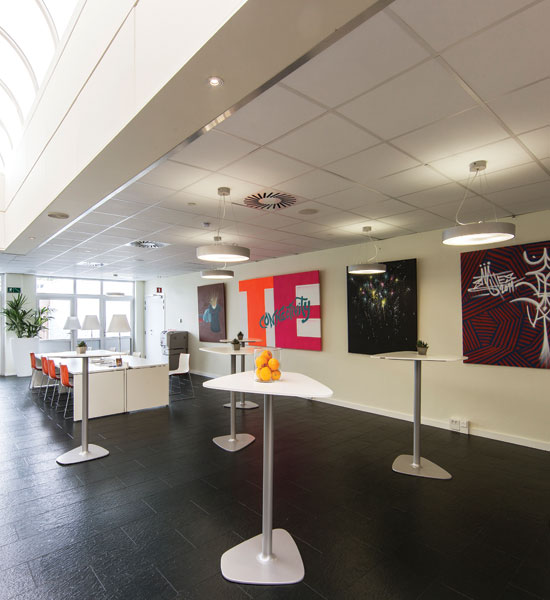The Value of Stone Wool Acoustical Ceilings
Indoor Environmental Quality
There are a number of ways that ceilings can contribute to improved indoor environmental quality (EQ). We have mentioned how higher light reflectivity can aid in extending daylighting into the space. LEED v4 recognizes that fact as part of the Interior Lighting credit under Lighting Quality which allows designers to demonstrate compliance by identifying four specific strategies from a list of eight provided. Several of these strategies identify specific average surface reflectance levels of 85 percent for ceilings among other things over 90 percent of the regularly occupied floor area. Stone wool ceiling tiles are readily available that meet or exceed this 85 percent level.

Photo courtesy of ROCKFON
Indoor environmental quality can be enhanced by natural daylighting and ceilings with high reflectance levels.
Beyond the light quality EQ trait, the emissions from ceiling tiles are addressed under the Low Emitting Materials credit. Ceilings must be 100 percent compliant in order to qualify for credit and points. One way to show compliance is for the ceiling tile to carry a GREENGUARD certification which is owned by Underwriters Laboratories (UL) as part of the UL Environment portion of that organization. Some stone wool ceiling products are pre-finished and qualify as low-emitting materials since they use low VOC content in the ceiling panels or the grids. Further, no added paints, coatings, adhesives, or harmful sealants are typically needed for ceilings. Based on these qualities, some stone wool ceiling systems qualify for GREENGUARD Gold Certification (formerly known as GREENGUARD Children & Schools Certification). This higher level of certification uses stricter criteria, considers safety factors to account for sensitive individuals (such as children and the elderly), and ensures that a product is acceptable for use in environments such as schools and healthcare facilities. It is referenced by both The Collaborative for High Performance Schools (CHPS) and the LEED Building Rating System.
It is also within the EQ credit section where the role that acoustics can play in terms of indoor environmental quality is addressed. In particular, LEED v4 Building Design and Construction (BD+C) contains a prerequisite for schools and a credit possibility for improved acoustics in different building types. For schools ANSI Standard S12.60 is the cited basis for performance. This standard and the EQ inclusion comes from studies that have demonstrated that excessive reverberation and noise in a classroom interfere with speech intelligibility which directly affects a student's ability to learn. Direct Sound in this case is the sound of a teacher's voice traveling directly from the teacher to the student. This is always beneficial in terms of speech intelligibility because the direct sound is not affected by anything in the room, making speech clear and distinct. It is the reflected or reverberating sound and intruding noise that interfere with the Direct Sound.
LEED v4 addresses Reflected Sound by requiring that the ceiling (or equivalent area of other room surfaces) has a minimum Noise Reduction Coefficient (NRC) of 0.70. Alternatively, another option is to comply with maximum Reverberation Time per the ANSI standard. LEED v4 sets maximum permissible Background Noise from HVAC systems at 40 decibels for the prerequisite and a lower 35 decibels for the credit. For the optional acoustic performance credit, you will also need to isolate the classrooms from sound that is generated outside the classroom or even outside the building, such as playground activity, traffic, planes, etc. that generally intrudes into the classroom by way of the windows. This means building walls and floors/roofs that comply with the minimum Sound Transmission Class (STC) requirements in the ANSI standard.
Using stone wool ceiling systems that have the appropriate NRC rating plus ensuring proper reverberation performance for different areas of the building will be necessary in order to meet the prerequisite and the credit point in a LEED for school buildings. In addition to schools, LEED v4 BD+C rating systems include similar credits for acoustic performance in other facility types such as commercial buildings, data centers, hospitality, warehouses/distribution centers, and healthcare. High-performing sound-absorptive ceilings can be used to contribute to the overall acoustic design and earning LEED points in this IEQ category.









